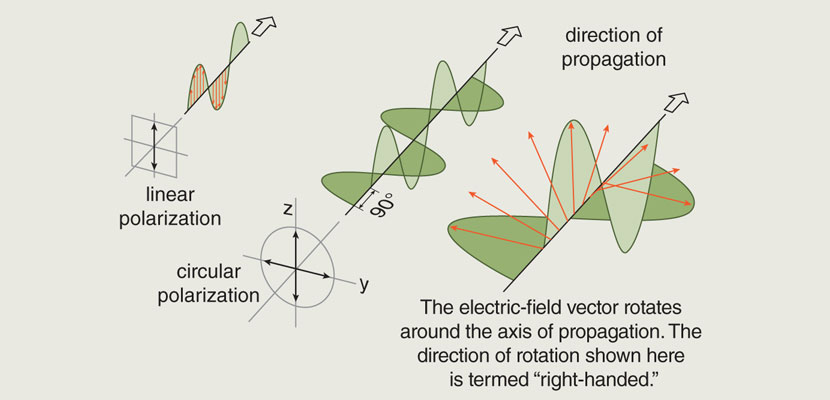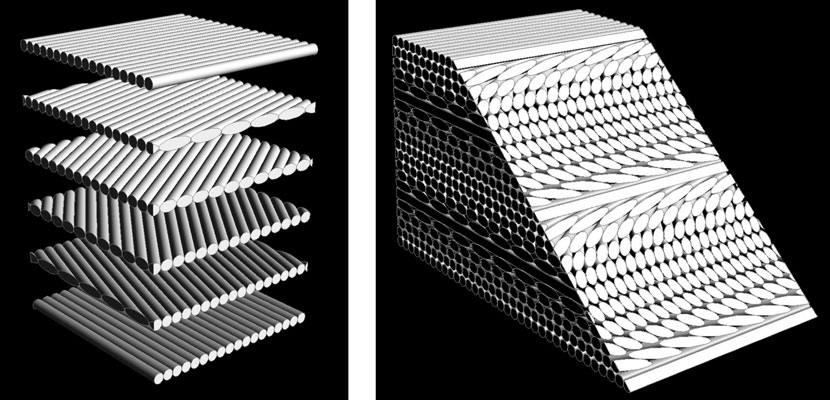An Unusual Shimmer
By Robert Frederick
The golden scarab keeps its shine even when other beetles do not. Now we better understand how, but not why, it does so.
The golden scarab keeps its shine even when other beetles do not. Now we better understand how, but not why, it does so.

To examine the outer shells, or cuticles, of shiny beetles, scientists can view them through filters like those found in modern 3D-movie glasses, which use both left- and right-handed circularly polarized filters (as the diagram below illustrates), one type of filter for each eye. Some shiny beetles reflect left-handed circularly polarized light, so although they still appear shiny through the left-handed filter, the right-handed filter eliminates the shiny color, allowing for closer examination. But the golden scarab beetle, Chrysina resplendens (pictured below), is different: It has a structural design that enables it to reflect both left- and right-handed circularly polarized light, and at roughly the same intensity.

Ewan Finlayson, University of Exeter
“It is unclear whether any other species of beetle or animal concurrently reflects left-handed and right-handed circularly polarized light,” says Pete Vukusic, who researches biophotonics at the University of Exeter in the United Kingdom. “If someone in a company were to design this, it would be a stunning innovation.”

Illustration by Barbara Aulicino
C. resplendens can reflect both types because it has a special layer in its cuticle that appears to work as a half-wave plate, transforming left-handed circularly polarized light into the right-handed circularly polarized light. It’s particularly innovative because C. resplendens has the same structures as the thousand other beetle species known to reflect left-handed circularly polarized light. It just has two such structures, separated by that special layer.
“This complex structure is very much of interest,” says Ewan Finlayson, because it could inform “a potential suite of novel optical components.” Finlayson is first author of the paper describing the work that he, Vukusic, and Luke McDonald published in the June issue of the Journal of the Royal Society Interface.
To examine that complex structure, the team employed the high-magnification imaging techniques of transmission electron micrography and scanning electron microscopy. Preparing the cuticle sample using accepted techniques resulted in a little shrinkage but did not otherwise affect the material’s structure. After analyzing the physical layers, measuring optical reflectance, and then creating computer simulations to model that reflectance, the team suggested a hypothesis for how light passes through and is reflected by C. resplendens’s cuticle.
As regular, unpolarized light strikes the top layer, the components of the light that are left-handed circularly polarized are reflected by the first such structure, which is formed from layers of aligned microfibers made of chitin, a polysaccharide common to beetle exoskeletons, embedded in a matrix of proteins (see diagram below). Components of the unpolarized light that are right-handed circularly polarized essentially just pass through that top structure. They next encounter that special layer, which converts the right-handed circularly polarized light to left-handed circularly polarized light. As the newly transformed left-handed circularly polarized light continues into the cuticle, it encounters the second structure of aligned chitin microfibers, and is strongly reflected back. That reflected left-handed circularly polarized light then reencounters that special layer and is converted back to right-handed circularly polarized light, which again passes through the upper structure and so back out of C. resplendens’s cuticle.

Image from the authors' research article, used with permission.
Fabricating synthetic versions of the cuticle would provide even more evidence in support of the hypothesis, but only for how it works in reflecting circularly polarized light, not why the beetle has this adaptation, which, so far, appears to be unique in the animal kingdom.
“Is it just an artifact of the way the cuticle grew,” asks Vukusic, or is it an adaptation that “produces a specific signal that works for antipredation or for mating—who knows?”
Because some light scatters as it passes through the cuticle, it takes many more layers of aligned chitin microfibers in the lower structure, beneath the special layer, to reflect as much right-handed circularly polarized light (overall) as the left-handed circularly polarized light reflected by the upper structure. And because the intensity of reflected circularly polarized light—both left- and right-handed—is roughly the same from the cuticle of C. resplendens, that suggests that the optical ambidexterity is not an artifact at all, but is evolutionarily important for some reason still to be discovered.
Correction: this article has been corrected, referring now to the special layer as made of chitin—a polysaccharide—embedded in a matrix of proteins. It had referred previously to chitin itself as a protein, a misstatement introduced in the editing process.
Click "American Scientist" to access home page
American Scientist Comments and Discussion
To discuss our articles or comment on them, please share them and tag American Scientist on social media platforms. Here are links to our profiles on Twitter, Facebook, and LinkedIn.
If we re-share your post, we will moderate comments/discussion following our comments policy.